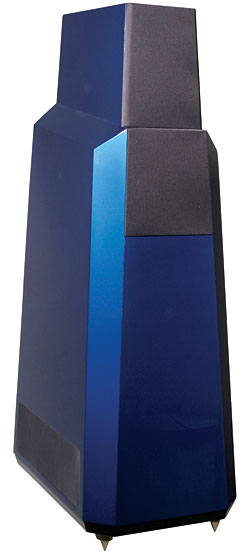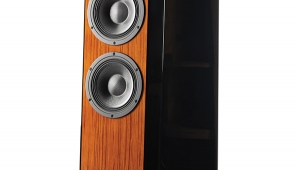| Columns Retired Columns & Blogs |
Vandersteen Model Seven loudspeaker
It's difficult to believe that the former top model of Vandersteen Audio's line of loudspeakers, the Model 5, has been in production in one form or another since 1997. Time passes quickly when you're having fun. Like all Vandersteen speakers, the 5 was and remains a good value and performance proposition. For all the 5's high technology and excellent performance both measured and audible, its price now starts at under $20,000/pair (up from about $10,000/pair when the 5 was introduced in 1997), including a built-in, proprietary powered subwoofer in each cabinet, and a sophisticated equalization system for room compensation.
 In the past, Richard Vandersteen has managed to keep costs down by doing away with stylish cabinets and wrapping his speakers' raw infrastructures in cloth socks—or, as in the Model 5, by splitting the difference: wood veneer below, a big burka-like hood above. But with the new Model Seven ($45,000/pair), Richard V. chucks any pretense of "value," aiming squarely for high style and even higher performance with a relatively small, dense package of new technology clad not in a sock or rich veneers, but in a sleekly angled, high-tech cabinet finished in flamboyant automotive paints.
In the past, Richard Vandersteen has managed to keep costs down by doing away with stylish cabinets and wrapping his speakers' raw infrastructures in cloth socks—or, as in the Model 5, by splitting the difference: wood veneer below, a big burka-like hood above. But with the new Model Seven ($45,000/pair), Richard V. chucks any pretense of "value," aiming squarely for high style and even higher performance with a relatively small, dense package of new technology clad not in a sock or rich veneers, but in a sleekly angled, high-tech cabinet finished in flamboyant automotive paints.
While the playing field has changed, particularly in terms of the materials used, Vandersteen has altered neither his goal of coherence of time and phase, nor his basic design strategy: a combination of meticulously shaped, minimally diffracting stepped baffle; a tightly packed, vertical array of drivers; and first-order, 6dB/octave, impedance-compensated crossover networks. All of these are found in the new Model Seven.
The modular, four-way Model Seven weighs a hefty 170 lbs, and is surprisingly compact at 44" H by 14" W by 20" D—smaller than the Model 5. Still, the Seven shares quite a bit with the 5: the same Vandersteen-designed, push/pull, side-vented subwoofer with down-firing aluminum-cone woofer, powered by a 400W amplifier; and the same 11-band room-compensation system with user-adjustable low-frequency contour.
Above the low bass, the Seven has a 7" ScanSpeak Illuminator midbass driver, transmission-line loaded; a 4.5" open-basket midrange unit patented by Vandersteen; a 1" ScanSpeak Illuminator dual-chamber tweeter, and, firing to the rear, a fully adjustable, 3/4" aluminum-alloy dome tweeter. By definition, this rear tweeter can't be time-coherent; it's there to be used in overdamped rooms. All of these drivers are built to Vandersteen's specs, and incorporate design innovations you can read about in Stereophile's previous reviews of Vandersteen products.
What's new here, and revolutionary, is Richard Vandersteen's proprietary Perfect-Piston cone design (patent pending). He makes the cones himself in a process that's costly in terms of time, labor, and expense, before shipping them off to ScanSpeak in Denmark, where they're incorporated into the driver structures, then shipped back to California. The Perfect-Piston comprises outer and inner "ultra-high-modulus" carbon-fiber cones, between them a balsa-wood cone made by Richard V. using a process of his invention. This begins with blocks of balsa that are sliced, machined, and baked in a special oven to remove any residual moisture. Why balsa? Airplane pilot Vandersteen found that, along with great strength and light weight, balsa behaves very well in a compressed, constrained-layer-damped usage—better, he says, than the structural foams, such as Rohacell, used by some other speaker manufacturers.
In the past few years Vandersteen has built up numerous iterations of this cone. He claims that they're remarkably stiff, light, and do behave in a pure pistonic manner, thus eliminating cone-breakup distortion for octaves above the intended upper passband. Considering that the Model Seven's midrange driver covers the unusually wide range of 600Hz–5kHz, that's an impressive claim. Use of the composite Perfect-Piston material in three of the Model Seven's five drivers (the subwoofer and rear-firing tweeter excepted) means that the same diaphragm material is reproducing all but the very lowest frequencies—which, Richard V. claims, produces the "ultimate in homogenous integration."
Like the driver baffles and plinths of the Quatro and Model 5A, the Model Seven's are of a molded epoxy composite, while the structural panels are of a bonded, constrained-layer-damped, nonresonant sandwich of multiple layers of carbon fiber, wood fiber, and elastomer. Additionally, the cabinet features a proprietary carbon-fiber–clad exterior and interior skeleton (which Vandersteen calls Carbon-Clad) that's applied by an aerospace supplier using a large, high-pressure, high-temperature autoclave. This unique combination of materials and processing is claimed by Vandersteen to create a unified structure virtually free of resonances: "one of the world's most rigid and silent loudspeakers in an affordable product."
Richard Vandersteen's definition of affordable has shifted upward in the 21st century—although, considering the towering prices of today's most expensive loudspeakers, perhaps $45,000/pair is now in the realm of the "affordable." However, the Model Seven's cabinet construction is clearly in a different realm from that of the already excellent Model 5, in terms of both complexity and damping abilities.
- Log in or register to post comments




































